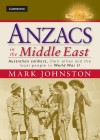Book Review - Anzacs in the Middle East: Australian soldiers, their allies and the local people in World War II
Anzacs in the Middle East: Australian soldiers, their allies and the local people in World War II
Written by: Mark Johnston,
Cambridge University Press, Melbourne, 2013,
ISBN: 9781107030961, 255 pp
Reviewed by: Tristan Moss, PhD student, Australian National University
During the first half of the Second World War, three Australian divisions and thousands of support troops played an important role in the war against Italy and Germany. Over a period of three years, Australian soldiers campaigned or were stationed in Egypt, Libya, Palestine, Lebanon, Greece and Crete. During this time, Australians invariably came into contact not only with the diverse nationalities of Commonwealth troops brought together to defend the empire, but also the culturally diverse and often alien local populations of the Middle East. It is these relationships, between Australians, their allies and the locals, into which Mark Johnston’s latest book delves.
The book’s eight chapters are anchored around the sites of Australian battles, training camps and places of leave, as well as transport to the theatre. The Australians’ relationship with other soldiers, particularly the British, is discussed throughout the book as contact was constant, while interactions with the locals are explored for the most part in the context of leave or training, focusing on one group at a time.
Since Australians served as part of a multinational force, usually under British control, Anzacs in the Middle East covers the sometimes turbulent relation- ship between troops from across the broad spectrum of the empire. Johnston’s detailed exploration of the British opinion of Australian soldiers follows the traditional trajectory of such discussions, but the book goes further than most other studies in its examination of the interactions between Australian and all other Commonwealth soldiers, as well as the Greeks and Cretans involved in the fighting. Johnston’s approach is to provide the reader with a general, balanced and colourful impression of these relationships, carefully building a portrait from accounts of all ranks and all national perspectives. Particularly interesting is Johnston’s examination of the influence of memories of the First World War, not only on perceptions of Australian soldiers by others, but also Australians’ own ideas of how they should act.
It is in its exploration of Australians’ relationship with the local population of the Middle East that Johnston’s book shines. Not only does he cover the traditional fare of larrikin diggers playing havoc in Cairo, he also delves into varied topics such as business relationships with Jews in Palestine, the attitudes of Greeks towards their retreating allies and Australian experiences on shore leave in Ceylon in 1940 on the way to Egypt.
Local people, particularly those of different cultures and ethnicities, have tended to be confined to broad stereotypes and pushed to the background in most Australian histories of the war. It is in bringing these people and their varied and extensive interactions with Australians to the fore that Johnston makes the strongest contribution to our understanding of this theatre. At the same time, Johnston pulls no punches in acknowledging that Australians were very much the products of their time and could hold views that were racist or offensive to modern sensibilities. But, he points out, so too could they have meaningful and strong relationships with the people of the Middle East that reached across the traditional distance of culture and race.
In Anzacs in the Middle East, Johnston draws on letters, diaries, and firsthand accounts. He is clearly at home with this material, his other books having been based on similar sources, and uses them to great effect to paint an engaging picture of Australian relationships. However, at times the structure is a little repetitious, with Johnston striving to portray a balanced relationship, describing first the negative aspects of a relationship, then the positive. Moreover, despite the reference to ‘Anzacs’ in the title, New Zealanders get short shrift; this perhaps speaks to the ongoing Australian appropriation of the term ‘Anzac’.
Overall, Anzacs in the Middle East is a rich history of Australians and their encounters with the myriad nationalities thrown together by the Second World War in the Mediterranean and the Middle East. Johnston adds colour and nuance to our understanding of the theatre, reminding us not only of the Australians’ varied encounters, but also of the fact that these encounters were an integral and important part of the wartime experience.



